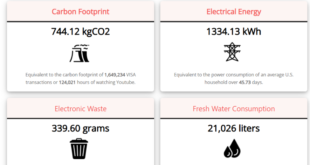This is a follow-up to my previous post on the end of US democracy and its implications. Here I will discuss how what’s left of the democratic world can respond. Surprisingly in many ways, the military part of dispensing with the US is the easiest bit, in each of its major areas of operation: Europe, Taiwan, and the broader Asia-Pacific region including Australian and New Zealand. As regards Europe, NATO would be massively stronger with the US (100 000 troops in Europe)...
Read More »The incredible cost of Bitcoin.
Source AI is not what it is supposed to be. Inspired by my son, who attends higher education, I asked chat-GPT to write an article about the energy use of bitcoin in the style of my blog post series ´The real costs of making money´. Look here. Guess what: chat-GPT did not emulate my style but… has a better style. Sadly, however, you can´t rely on it for the facts (I am impressed by the speed, however, even when superficial googling yields better results, especially when non-english...
Read More »Trump has thrown out the global economic playbook. It’s time for Australia to write its own rules
My latest from The Guardian =With the resumption of parliament this week, and an election only months away, we have seen even more of the usual point-scoring about the cost of living, tax breaks for long lunches and budget deficits. But since the return of Donald Trump to the White House, the assumptions on which Australian economic policy have always been based are obsolete. We must ditch the illusion that the US will return to normal and instead become more self-reliant With...
Read More »Weekend read: Keynes’ critique of econometrics is still valid
from Lars Syll Mainstream economists often hold the view that Keynes’ criticism of econometrics resulted from a sadly misinformed and misguided person who disliked and did not understand much of it. This is, however, nothing but a gross misapprehension. To be careful and cautious is not the same as to dislike. Keynes did not misunderstand the crucial issues at stake in the development of econometrics—quite the contrary. He knew them all too well and was not satisfied with the validity and...
Read More »Here we are
from Peter Radford Random thoughts on day one of America’s war on the world. This is my way of summarizing, it is not definitive by any means! I wrote in haste. Here’s a quote to get us started: “What made fascism attractive in Europe and elsewhere was its combination of national autarkic aims, militarism, statism, and a glorification of technology, which suited the inclinations and interests of military rules and modernizing autocrats.” [Osterhammel and Peterson; “Globalization, A...
Read More »Germany’s election & why it is important to understand the Ukraine War
I urge you to watch this YouTube mini documentary (30 minutes). If that is too long, watch just the segment from 10:30 -12:00 (1.30 minutes). Jeffrey D. Sachs – Understanding the Ukraine conflict – Brave New Europe Every German should watch this before voting in the February election (and every European should watch in advance […]
Read More »The dispensable nation
“The cemeteries are full of indispensable people.” In one form or another, this observation has been made many times over the last century or more. What is true of people is true of nations. In the past 25 years or so it was often claimed (and , admittedly, often denied) that, in the modern world, the United States was the “indispensable nation”. Whatever the rights and wrong of this claim, it has become obvious that, whether we like it or not, the rest of the world will now have to...
Read More »Donald Trump is badly nonfused # 67,218: The story of supply and demand
from Dean Baker Donald Trump is the world’s leading expert in getting things wrong and one thing he gets wrong bigly is the value of the U.S. domestic market. Trump seems to believe that our domestic market is incredibly valuable to the rest of the world and that access to it should allow him to extort large concessions from the rest of the world. This is a seriously wrong understanding of the world economy. The basic point is a simple one, when other countries sell us things, they are...
Read More »Australia (Act) Day (annual repost)
As usual, 26 January has been marked by protests, denunciations of those protests, and further iterations. Even apart from the fact that it marks an invasion, the foundation of a colony that later became one of Australia’s states isn’t much of a basis for a national day. A logical choice would be the day our Federation came into force. Unfortunately for this idea, our Founders chose 1 Jan 1901. The first day of the 20th century[1] must have seemed like an auspicious choice for a...
Read More »Trump open thread
I’ve already said all I plan to (for now) about what’s happening in the US. But if others want to discuss it, here’s an open thread. Share this:Like Loading...
Read More » Heterodox
Heterodox



